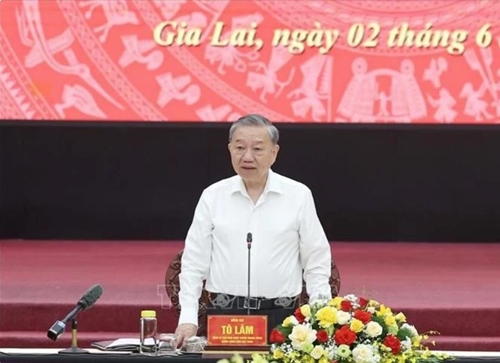During a working session with the standing board of the Gia Lai provincial Party Committee and permanent members of the Binh Dinh provincial Party Committee in Gia Lai on June 2, Lam underscored the need to fully harness the strategic similarities and complementarities between the two provinces, considering them a crucial foundation for a shared development vision.
    |
 |
|
Party General Secretary To Lam speaks at the meeting. |
The proposed merger aims to forge an East-West economic corridor, connecting the Central Highlands with the coastal region through National Highway 19 and the Quy Nhon - Pleiku Expressway. This corridor, Lam stressed, promises breakthroughs in logistics, transportation, trade, and regional connectivity, unlocking new avenues for economic growth.
Economically, the merger is a masterstroke of strategic complementarity. By integrating production, processing, distribution, and export channels, the new entity will foster a seamless value chain that supports green, sustainable development and global integration.
Tourism stands to gain immensely from this combination. Gia Lai, with its lush forest ecosystem, vibrant highland culture, and the renowned gong heritage, would complement Binh Dinh's historic Tay Son relics, pristine beaches, traditional craft villages, and rich culture and arts. Together, they could create unique inter-regional tourism routes that will captivate visitors and elevate the region's brand on the national tourism map.
In terms of human resources and governance, the merger presents a compelling narrative of dual advantage. Gia Lai's young, abundant workforce, coupled with Binh Dinh's robust vocational training and university systems, would cultivate a skilled labor pool and a modern, efficient civil service, essential for rapid, sustainable, and comprehensive development.
    |
 |
|
An overview of the meeting |
Gia Lai and Binh Dinh were urged to pool their brainpower to envision a new Gia Lai that proactively builds a long-term development vision and sets out strategic breakthroughs in governance, infrastructure, sci-tech, and human resources.
Central to this vision is the development of a balanced, interconnected region with modern logistics and inter-regional infrastructure. Tourism, identified as a high-potential sector, would focus on creating a unique ecosystem linking coastlines, forests, and cultural heritage sites, including the gong culture and Tay Son legacy. Eco-resort and community-based tourism is also expected to enhance its appeal.
Urban development would integrate satellite areas with industrial, logistics, and tourism hubs, underpinned by digital governance to ensure transparency and efficiency. Lam outlined three strategic priorities for new Gia Lai: institutional reform, enhanced connectivity infrastructure, and human resource development.
As Vietnam’s second-largest province by area, the new province would also play a critical role in safeguarding national territory, ensuring political stability, and preserving the cultural identities of its diverse ethnic communities, particularly those in remote, mountainous, and ethnic minority areas.
Source: VNA